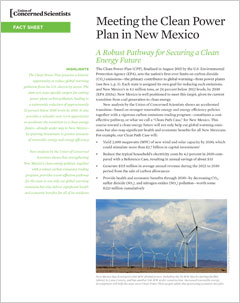The Clean Power Plan sets the nation's first-ever limits on carbon dioxide (CO2) emissions—the primary contributor to global warming—from power plants.
Each state is assigned its own goal, and New Mexico’s is 4.1 million tons, or 24 percent below 2012 levels, by 2030. New Mexico is well positioned to meet this target, given its current shift away from coal generation and growing investments in renewable energy and energy efficiency.
Widespread economic and health benefits
New analysis shows that an energy transition based on strong renewable energy and energy efficiency policies, together with a vigorous carbon emissions trading program, would constitute a cost-effective pathway, or "Clean Path Case," for New Mexico.
This course toward a clean energy future will:
- Yield 2,400 megawatts (MW) of new wind and solar capacity by 2030, which could stimulate more than $2.7 billion in capital investments
- Reduce the typical household’s electricity costs by 4.3 percent in 2030 compared with a Reference Case, resulting in annual savings of about $33
- Generate $115 million in average annual revenue during the 2022 to 2030 period from the sale of carbon allowances
- Provide health and economic benefits through 2030—by decreasing CO2, sulfur dioxide (SO2), and nitrogen oxides (NOx) pollution—worth some $223 million cumulatively
Recommendations for securing a clean energy future
Achieving the Clean Path Case’s full range of benefits will require policy makers and regulators to work together with utilities, generators, advocates, regional transmission organizations, and other stakeholders to develop a Clean Power Plan (CPP) compliance plan that generates widespread benefits for New Mexico.
- The New Mexico Environment Department (NMED) should develop a strong mass-based CPP compliance plan. In building this plan, the NMED should prioritize renewable energy and energy efficiency, and it should develop a mass-based emissions trading program that includes both new and existing sources and allows for interstate trading of carbon allowances.
- The New Mexico legislature should authorize the state to auction carbon allowances as part of the NMED’s emissions trading program. Revenues generated from the auctions should be directed toward programs that benefit all residents, reduce carbon emissions, and promote equitable approaches to transitioning to a low-carbon economy.
- The New Mexico legislature should enact strong clean energy policies. The legislature should extend and expand its current RPS, which is set to level off at 20 percent in 2020. New Mexico’s EERS should also be increased and extended beyond 2020 in conformance with leading EERS states, which require utilities to reduce electricity use by 1.5 to 2 percent each year.
- New Mexico electricity providers should work to diversify their electricity portfolios, prioritizing low-cost renewables and efficiency. These steps will help cut consumer electricity bills and further curb harmful emissions from power plants.
With well-designed policies and careful planning and coordination, New Mexico could greatly enhance its clean energy resources, cost-effectively comply with the emissions reductions required by the Clean Power Plan, and reap important economic and public health benefits.
These benefits would help ensure a sound and prosperous future for all New Mexicans.




